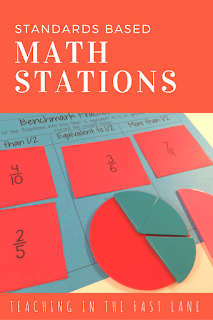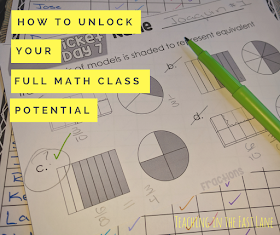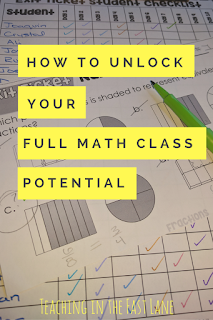We have all struggled to make our math class the most it can be. With a growing number of standards thrown at our students each year, it can be a struggle to feel successful while teaching math.
There I sat at my blue, small group table with my head in my hands. I had graded yet another district assessment, and the results were not good. I had followed the plan, I worked hard every day to fit it all in, and still, we had failed. I had failed.
I began to rethink my plan. Instead of trying to throw everything against the wall and see what stuck I would be more methodical, more strategic. I had to find a way to reach my students which wasn't happening now.
What I Was Doing
I had always taught math whole class. We relied heavily on the document camera and projector to go through many, many examples together then they practiced, but still heavily under my guidance. A small amount of time was spent on math stations and small group, usually during review periods.
This method had worked for years, but then the standards changed. With the more rigorous standards, I saw a need for change.
What I Began Doing
The first change made was to shift from the most lengthy part of our math block being teacher focused and whole group to a more student-focused small group and math station approach.
This meant I was able to spend more time focusing on students who needed my help and accelerate the learning for those who had already mastered the standard we were working on.
Then came the structure of our math block. Once I saw how this changed up approach was working I spent some more time building in structure. I am incredibly structure driven, as are most students, and while they were enjoying the new found freedoms of more station work I needed each day in math to look and feel consistent.
The Structure of a Math Block
Each math block begins with a warm-up or review of the standards we are currently working on. This consists of typically four questions and should not take students more than 3-5 minutes to complete. We go over this warm-up together and students use their tracking sheet to highlight areas they are excelling in as well as areas where they can set goals to improve.
Next, we take part in the whole group portion of the math block. This didn't go away from our original structure, but it did shrink way, way down. Whereas an old whole group lesson would have taken thirty or more minutes of our math block our new whole group lessons are mini, even micro-lessons, typically lasting a max of ten minutes.
During this time we make and discuss anchor charts, have number talks, and model problem-solving strategies for the concepts we are working on.
From there, students practice their learning from the mini-lesson. I tried to incorporate as much cooperative learning as possible because my students excel when working with peers, as most do. This practice piece should again, take no longer than ten minutes.
Finally, we would get to the meat of our math block. This time, the bulk of our block was spent with students working in standards-based stations with partners and me, working with a small group. While this was the largest part of our ninety-minute math block it was also the most flexible.
Students were assigned partners, but the partner chose stations to complete so long as they reached them all within the time period allotted. I worked with students in a small group to reinforce the standards we were working on in a more immediate way than I was able to during whole group. This meant students' needs were being met more quickly, all while providing them with more autonomy.
At the end of the math block, we would clean up and come back together to complete an exit ticket. I prefer to have exit tickets match the standards being learned in the unit, but connect our learning to standardized testing. This meant I did not have to "teach to the test," but my students were still seeing the style of question they might encounter later in the year.
Our exit tickets took about three minutes to complete and collect and then we would go over the question together for about another two minutes.
Overview of our structure for a 90-minute math block:
Warm-Up 5 minutes to complete 2 minutes to check
Warm-Up 5 minutes to complete 2 minutes to check
Mini-Lesson 10 minutes
Practice 10-15 minutes
Small Group and Station Work 55-60 minutes
Exit Tickets 5 minutes
Tips for Success
The move from whole group math to more student-focused was not easy and took a lot of self-control on my part. I mean, was two examples enough, or did they need more?
My biggest struggle was with sticking to the mini-lesson being mini and not turning it into an ordeal. I had to remind myself over and over again I would see these students again in small group and would be able to work out any misconceptions or confusion then when it was easier to do.
I also struggled to let go of control in the area of math stations. It would have been easier to me to assign partners to stations and tell them when to switch as I switched math groups, but would have taken away from their autonomy and would have likely lowered their engagement.
Instead, I focused on making sure every station was full of quality materials would challenge my students to look at the standards in a different way. Each station available to them was standards-based and high quality. I also explicitly modeled my expectations for station work and held all of my students to these high standards throughout the year. This meant accountability for my students and made all the difference.
Where Do You Find Materials?
 To be honest, when I first moved our math block in this direction it was a struggle. I used what we had and made it work, but slowly I pulled together resources meant for this by creating my own.
To be honest, when I first moved our math block in this direction it was a struggle. I used what we had and made it work, but slowly I pulled together resources meant for this by creating my own.
Now I have math station sets which each have ten math stations based on the same standard. This means students can see a standard in ten different ways allowing them to continue practicing the standard for mastery. These stations are built around the concept of gamification to keep student engagement high. Most stations include a recording sheet, and if applicable, an answer key to hold students accountable for their work.
You can check out these stations here:
Along with math stations, I have also begun creating full units for math, beginning with fourth grade. Each unit includes a preassessment, content vocabulary shown in three ways, daily warm-ups, lessons and student activities, daily exit tickets, a post-assessment, and ideas for how to continue the lesson in small group. You can find these units here, or get the most bang for your buck with the bundle here.



No comments:
Post a Comment